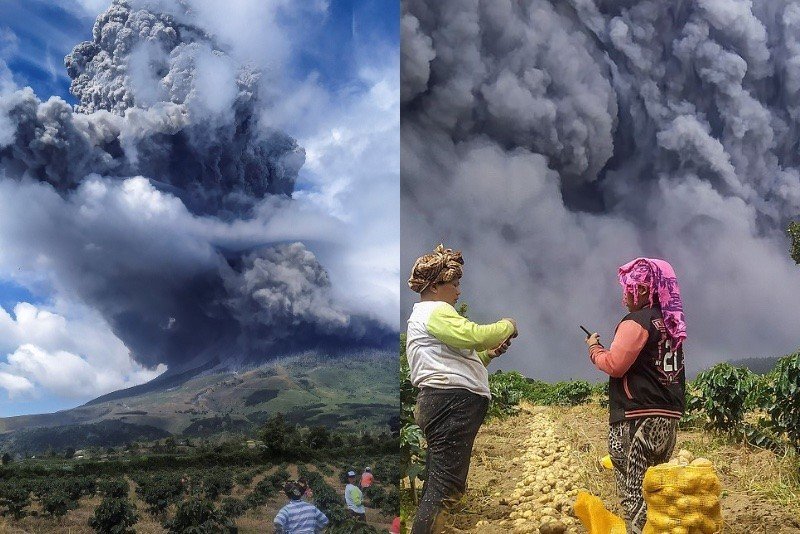Authorities have advised the public to remain alert over potential future eruptions at Mount Sinabung in Karo regency, North Sumatra, as the volcano has erupted several times since the weekend following a year-long absence of volcanic activity.
The latest string of eruptions occurred on Monday, with Mt. Sinabung spewing a 5,000-metre-high column of volcanic ash and smoke from the peak of the mountain at 10.16 a.m, followed by a second eruption at 11.17 a.m that produced a 2,000-m-high column of ash, according to the Volcanology and Geological Hazard Mitigation Center (PVMBG).
PVMBG official and personnel of the Sinabung observation post, Armen Putera, told The Jakarta Post that the volcanic ash from Monday’s eruption had covered at least three districts in Karo and turned the sky dark, especially in Namanteran district, which is located 5.2 kilometres from the mountain.
More eruptions are likely to ensue in the following days, given the recent increase in frequency of tectonic earthquakes that rattled the volcano, he said.
“We have recorded increased tectonic earthquakes in Mt. Sinabung over the past 12 hours. These are signs of eruptions,” Armen said, “We have to increase our vigilance and avoid the danger zone of Mt. Sinabung.”
At least three districts Namanteran, Merdeka and Berastagi had been directly affected by Monday’s eruptions and covered by volcanic ash, according to the Karo Disaster Mitigation Agency (BPBD).
“Residents have been forced to halt their activities because the ash is thick, [the afternoon] sky is similar to a night sky because it is covered in ash,” BPBD Karo acting chairperson Natanael Perangin-angin told the Post.
Mt. Sinabung erupted again for the first time after 14 months of inactivity at 1.58 a.m. on Saturday, spewing a 2,000-m-high column of volcanic ash that later spread as far to Berastagi, located some 30 km from the volcano.
A second eruption occurred later at 5.18 p.m on the same day, producing a 1,000-m-high column of ash.
M. Nurul Asrori, another personnel of the Sinabung observation post, told the Post on Sunday that the eruptions over the weekend indicated that Mt. Sinabung had turned active again following its period of inactivity.
The PVMBG could not precisely predict when the next eruption would take place, but considering the recent situation, Nurul said a subsequent eruption of a larger scale was imminent.
Read Also
Flash floods, landslides kill 9 in Indonesia
“We ask residents and tourists to exercise caution, stay away from Mt. Sinabung. Keep your guard up, because a larger eruption could occur anytime,” he said.
As of Monday afternoon, the local administration has yet to issue an official evacuation order for residents who live near the volcano.
The majority of them have reportedly remained in their homes to clean up their yards and plantations from volcanic ash.
Natanael of the BPBD Karo also reminded the public to steer clear of areas designated as “danger zones” that surrounded the volcano, especially after local authorities found that a number of locals and tourists still trying to enter the areas for sightseeing on Sunday.
“This is very dangerous because Mt. Sinabung can erupt again at any time,” he said, adding that a patrol team deployed by the agency on Sunday had since escorted the civilians to safety.
The 2,460 m Mt. Sinabung roared back to life in 2010 for the first time in 400 years. After another period of inactivity, it erupted once more in 2013 and has remained highly active since.
At least 16 people died in one of Sinabung’s eruptions in 2014. Two years later, another eruption killed seven.
Indonesia is home to about 130 volcanoes because of its position on the Ring of Fire, a belt of tectonic plate boundaries circling the Pacific Ocean where frequent seismic activity occurs.




